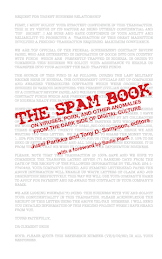Before leaving finally for ISEA 2010 in Germany I shall post this -- a short intro, or summary, or the extended abstract of what we are going to talk about there with Tony Sampson. It continues the Spam Book themes, and addresses more concretely the link between such processes as contagion (and in relation to heterogeneous bodies from social relations to software) and capitalism -- more specifically marketing techniques, and various ways of harnessing the pull of connectedness.
Learning from Network Dysfunctionality: Accidents, Enterprise and Small Worlds of Infection
Tony D. Sampson (University of East London, UK)
Jussi Parikka (Anglia Ruskin University, UK)
In February 2010 an outbreak of media panic spread through the British tabloid press concerning a marketing campaign called DubitInsider. The DubitInsider website recruits 13-24 year olds who consider themselves to be “peer leader[s] with strong communication skills” to act as “Brand Ambassadors”. This requires the clandestine passing-on of product suggestions to peers via posting on message boards and social networks, emails and instant messenger conversations, organizing small events and parties. DubitInsider ignited the moral indignation of the tabloids not because of its covert nature, but since Brand Ambassadors were apparently paid to market “unhealthy” junk foods to minors. Tapping into the social influence of the consumer is nothing new. Seeking out so-called influentials is the basis of seasoned word-of-mouth campaigns and persists in “word-of-mouse” variations. For example, in4merz.com exploits the anticipated contagiousness of relations established between friends “on and offline” to promote music acts. “In4merz is about matching our artists to your friends who may like them.”
Young In4merz create posters, banners and videos about acts, Twitter about them, leave comments on Facebook etc. For each level of promotion, In4merz earn points that convert into CDs, DVDs, concert tickets and potential backstage access.
What interests us, as analysts of network dysfunctionality, is how the logic of these marketing strategies overlaps with the same anomalous abstract diagrams that distribute spam and viruses. In a different context, hiding unsolicited brand messages in social media and the potential for the bulk sending of veiled product promotions for financial reward could arguably be called spamming.
Furthermore, designed as they are to spread Trojan-like suggestions through imitative social networks, whether or not the strategies actually become contagious, their aim is to go viral. When removed from the context of the anomalous Nigerian cybercafe or computer virus writing scene, and played out in the marketplaces of food and pop culture, the emergent spam logic and virality of network capitalism becomes part of a broader indexical change concerning the way contagious communication networks, vulnerable bodies and unconscious behaviours can be harnessed.
The logic adopted becomes a normalized online marketing activity, not only performed by corporations, but embedded in social relations of individuals as part of the strategies of business enterprise and brand design.
Spamming and virality are no longer anomalies then, but are fast becoming the standard, acceptable way of doing business in the digital world. If the peer-to-peer recommendations and thumbs-up-buttons of “word-of-mouth 2.0” characterize the current paradigm of social media, these campaigns are indicative of a more aggressive and targeted Web 3.0 marketing of suggestion already on the horizon. This is a Web 3.0 that appeals directly to a user’s emotional landscape and desire for intimacy (Ludovico 2005), and exploits the ready made expediency of contagiousness networks that pass on suggestion.
Following a similar neo-monadological approach set out by Lazzarato (2004) we articulate the dynamics of spam, viruses, and other related “anomalies”, as constituent parts of new infectious worlds “created” by the business enterprise. We focus on the specific creative capacities of dysfunctionality in the production of network environments, and how “learning” from the irregularities of normalized communication adds new flesh to this world. We discuss how new knowledge concerning the productive powers of the anomalous is filtered through what Thrift (2005) calls the cultural circuit of capitalism: “… a feedback loop which is intended to keep capitalism surfing along the edge of its own contradictions”.
This new knowledge, acquired from the accidental events of the network, is seized upon by the business enterprise, leading to new consumer modeling intended to make ready environments so that the capricious spreading of social influence can be all the more effectively triggered and responded to.
Zittrain (2009) argues that viruses, spam and worms are threats to the generative principle of the Internet. Similarly, we contend that such software-driven social actions are exploitative of the open principles of the Internet, but further acknowledge the extent to which these practices have enthused and inspired the business enterprise. As we see it, “bad” software is not necessarily “malicious”. It becomes integral to an alternative generative logic of capture implicated in the production of new worlds of infection. We will discuss how these epidemiological worlds were mapped by computer scientists in the 1980s before they pervaded the burgeoning offshoots of the billion dollar network security industry. We further chart how they were modeled by network science as early as the 1960s and are currently being exported, via the circuitry of capitalism, to the business enterprise.
To be published in full as a chapter in The Blackwell Companion to New Media Dynamics, Hartley, Burgess and Bruns (eds.), Wiley-Blackwell, (forthcoming).








No comments:
Post a Comment